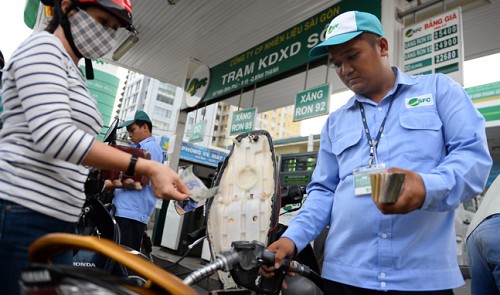Vietnam ministry unveils draft fuel trading law in hopeful sign
The Ministry of Industry and Trade has finished a draft decree on fuel trading with many amendments that will hopefully enable fuel prices in Vietnam to be in accordance with global development and reduce consumers’ dissatisfaction over the current market management.

The draft, intended to replace the Decree No.84 that has been in effect since 2009, has been submitted to the Prime Minister for approval.
According to the draft decree, when the fuel prime cost goes down within a range of two percent, fuel wholesalers must cut their retail prices accordingly.
The fuel prime cost includes imported prices, taxes, fees and other expenses.
In case the prime cost surges within the two percent margin, the wholesalers will be allowed to increase their retail prices without obtaining approval from the regulatory bodies. They only have to inform them of the new prices via documents.
The current margin of adjustment is seven percent, which has caused Vietnamese consumers to suffer shocking fuel price increases.
The smaller two percent margin will thus result in less drastic fuel price hikes, which are more acceptable to consumers, according to industry insiders.
In case the prime cost rises within a band from two to seven percent, the fuel firms will have to send their price adjustment plans to the ministries of industry and trade and finance for consideration two days before they announce the price hike.
The draft decree also stipulates an interval of at least 15 days between two fuel price increases, and a maximum of 15 days between two price cuts.
The prime cost will also be calculated based on the average global fuel prices in 15 days instead of the current 30 days.
Trinh Quang Khanh, deputy chairman of the Vietnam Fuel Association, said the two percent margin for price adjustment is appropriate.
“As petrol prices currently revolve around VND25,000 (US$1.18) a liter, the two percent margin means prices will only go up or down no more than VND500 a liter,” he said.
“With the seven percent margin, consumers can suffer price hike of VND1,300 a liter.”
A fuel expert meanwhile said calculating the prime cost based on the average global fuel prices in 15 days will help Vietnamese fuel prices to develop in a more similar way to global rates.
“It will curb the phenomenon in which fuel prices in Vietnam soar when global rates are slumping, and vice versa,” he explained.
Vietnam has hiked fuel prices three times so far this year. A92 gasoline, the most popular fuel in the country, currently sells at VND24,900 ($1.17) a liter, following an increase on April 22.
 Thu Dau Mot City proactively and effectively promotes Party congresses at all levels
Thu Dau Mot City proactively and effectively promotes Party congresses at all levels
 Organization Subcommittee serving the 12th Provincial Party Congress passes the organizational plan to serve the congress
Organization Subcommittee serving the 12th Provincial Party Congress passes the organizational plan to serve the congress
 Legislature adopts revised Trade Union Law
Legislature adopts revised Trade Union Law
 Dien Bien provincial Party Committee's Mass Mobilization Commission visits "Morning Coffee - Exchange with the people" model in Binh Duong
Dien Bien provincial Party Committee's Mass Mobilization Commission visits "Morning Coffee - Exchange with the people" model in Binh Duong
 Vietnam – Malaysia relations develop strongly in new period
Vietnam – Malaysia relations develop strongly in new period
 Youth Union enhances propaganda on all-level Party Congress
Youth Union enhances propaganda on all-level Party Congress
 Provincial Party Committee announces personnel decisions
Provincial Party Committee announces personnel decisions
 Provincial delegation pays working visit to Germany
Provincial delegation pays working visit to Germany
 Provincial People's Council Chairman takes part in "Morning Coffee - Exchange with people" in Hiep Thanh ward
Provincial People's Council Chairman takes part in "Morning Coffee - Exchange with people" in Hiep Thanh ward
 Honoring traditional values, strengthening solidarity
Honoring traditional values, strengthening solidarity






